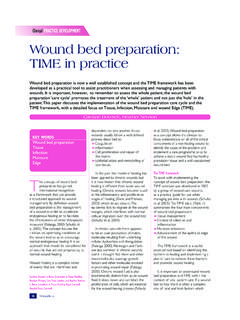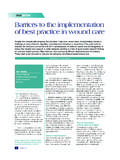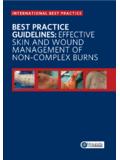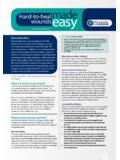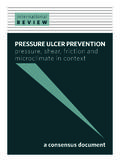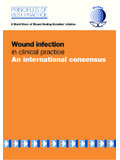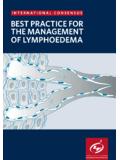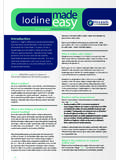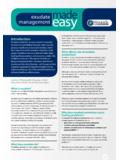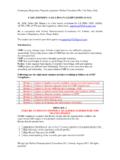Transcription of APPROPRIATE USE OF SILVER DRESSINGS IN …
1 INTERNATIONAL. CONS E N S U S. APPROPRIATE USE OF SILVER . DRESSINGS IN WOUNDS. an expert working group consensus EDITOR: Lisa MacGregor FOREWORD. PUBLISHER: Topical antimicrobial DRESSINGS , including those that contain SILVER , are used to prevent or Kathy Day manage infection in a wide range of wounds. Although SILVER DRESSINGS have been used PUBLISHED BY: extensively, a recent study1 and two Cochrane reviews2,3 have concluded that there is Wounds International insufficient evidence to show that SILVER DRESSINGS improve healing rates. The overall effect Enterprise House has been to cast doubt into the minds of healthcare purchasers and to cause restrictions in 1 2 Hatfields the availability of SILVER DRESSINGS worldwide.
2 There is growing concern amongst clinicians London SE1 9PG, UK that arbitrary withdrawal of SILVER DRESSINGS could lead to increased morbidity and Tel: + 44 (0)20 7627 1510. Fax: +44 (0)20 7627 1570. prolonged treatment time relating to uncontrolled wound bioburden. A group of experts from Europe, North America, the Far East, South Africa and Australia met in December 2011 to provide internationally-recognised guidance for the proper use Wounds International 2012 of SILVER DRESSINGS , based on experience in clinical practice and all the available evidence. This document presents the mechanisms by which SILVER DRESSINGS work, the relationship of in vitro and in vivo evidence to clinical practice and provides a rationale for cost-effective management.
3 Following the consensus meeting, a draft document was produced, which underwent extensive review by the expert working group. Additional international experts were This document has been developed by Wounds also consulted to reflect practice across different parts of the world. This culminated International and supported in a consensus by all members of the extended expert working group on all statements by an unrestricted educational presented in the document. grant from B Braun, ConvaTec and Systagenix. Professor David Leaper The views expressed are those . of the expert working group and review panel and do EXPERT WORKING GROUP.
4 Not necessarily reflect those Elizabeth A Ayello, Excelsior College School of Nursing, Albany, New York (USA). of B Braun, ConvaTec and Keryln Carville, SILVER Chain Nursing Association & Curtin University, Osborne Park, Perth Systagenix. (Western Australia). Jacqui Fletcher, Section of Wound Healing, Cardiff University (UK). David Keast, Aging Rehabilitation and Geriatric Care Research Centre, St Joseph's Parkwood How to cite this document: Hospital, London, Ontario (Canada) (Co-Chair). International consensus. APPROPRIATE use of SILVER DRESSINGS David Leaper, Wound Healing Research Unit, Cardiff University (UK) (Chair).
5 In wounds. An expert working Christina Lindholm, Sophiahemmet University College, Karolinska University Hospital, Stockholm group consensus. London: (Sweden). Wounds International, 2012. Jos Luis L zaro Mart nez, Diabetic Foot Unit, Complutense University, Madrid (Spain). Available to download from: Silindile Mavanini, Inkosi Albert Luthuli Central Hospital, Durban (South Africa). Andrew McBain, School of Pharmacy and Pharmaceutical Sciences, University of Manchester (UK). Zena Moore, Faculty of Nursing & Midwifery, Royal College of Surgeons in Ireland, Dublin (Ireland). Supaporn Opasanon, Division of Trauma Surgery and Burn Unit, Department of Surgery, Siriraj Hospital, Mahidol University (Thailand).
6 Elaine Pina, National Programme for Infection Control, Directorate General of Health, Lisbon (Portugal). REVIEW PANEL. Valerie Edwards-Jones, School of Research, Enterprise and Innovations, Faculty of Science and Engineering, Manchester Metropolitan University, Manchester (UK). Jenny Hurlow, Plastic Surgery Group of Memphis, Tennessee (USA). SILVER DRESSINGS current issues COMMON TERMS THE HISTORY OF SILVER . EXPLAINED The topical antimicrobial agent SILVER has been used for hundreds of years in wound care4. Bacteriostatic: prevents For example, SILVER has been used to prevent or manage infection in its solid elemental bacteria from growing or form (eg SILVER wire placed in wounds), as solutions of SILVER salts used to cleanse wounds reproducing (eg SILVER nitrate solution), and more recently as creams or ointments containing a SILVER .
7 Bactericidal: kills bacteria antibiotic compound ( SILVER sulfadiazine (SSD) cream). Oligodynamic: active or effective in very small SILVER nitrate solution is less widely used nowadays, but SSD cream has been an important quantities part of burns management for many years5. SSD cream, however, is relatively short-acting, In vivo: experimentation on a whole living animal requires reapplication at least daily, and is time-consuming and messy to apply and remove. In vitro: experimentation on components of an In recent years, a wide range of wound DRESSINGS that contain elemental SILVER or a SILVER - animal or organism releasing compound have been developed (see Appendix 1, page 20).
8 These DRESSINGS Antimicrobial tolerance: have overcome some of the problems associated with the first SILVER preparations. They are bacteria in a biofilm may easier to apply, may provide sustained availability of SILVER , may need less frequent dressing take on a dormant state changes, and may provide additional benefits such as management of excessive exudate, in which their slower maintenance of a moist wound environment, or facilitation of autolytic debridement6. metabolism makes them less susceptible to the effects of antimicrobials The use of SILVER DRESSINGS in wound care has recently been faced with considerable Antibiotic resistance: challenges.
9 These include a perceived lack of efficacy and cost effectiveness, and the ability of bacteria to questions about safety1 3,7,8. In some healthcare settings, these challenges have led to avoid harmful effects restrictions in the availability or complete withdrawal of SILVER dressings9,10. This has left of antibiotic agents by some clinicians in the frustrating position of not being able to use SILVER DRESSINGS for undergoing genetic changes patients who may find them beneficial. In the context of increasing resistance to antibiotics and the dramatic fall in the number of antibiotics in development, restriction of other potentially useful antimicrobial treatments such as SILVER DRESSINGS is particularly unfortunate11,12.
10 Topical antiseptics, such as SILVER , differ from antibiotics: they have multiple sites of antimicrobial action on target cells and therefore a low risk of bacterial resistance13. As a result, antiseptics have the potential to play an important part in controlling bioburden in wounds while limiting exposure to antibiotics and reducing the risk of development of further antibiotic resistance. See Box 1 below for more information on antimicrobial agents. BOX 1: Antimicrobial agents (modified from14 16). Antimicrobial any agent that kills or prevents the multiplication of microorganisms, eg bacteria or fungi. Antimicrobials may be antibiotics, antiseptics or disinfectants Antibiotics agents that act selectively against bacteria and may be administered systemically or sometimes topically (although topical antibiotics are not recommended for wounds).
